Ant 200 Exam 2
1/56
There's no tags or description
Looks like no tags are added yet.
Name | Mastery | Learn | Test | Matching | Spaced |
|---|
No study sessions yet.
57 Terms
What is animal behavior
How individuals respond to internal and external stimulu- social, structural, physiological
Ex: Imprinting. A human is there during the birth of baby chicks, as a result the baby chicks will respond by following the human(imprinting).
What are examples of Animal behaviors
Instinct
chemicals
Foraging behaviors
Social behavior(dominant)
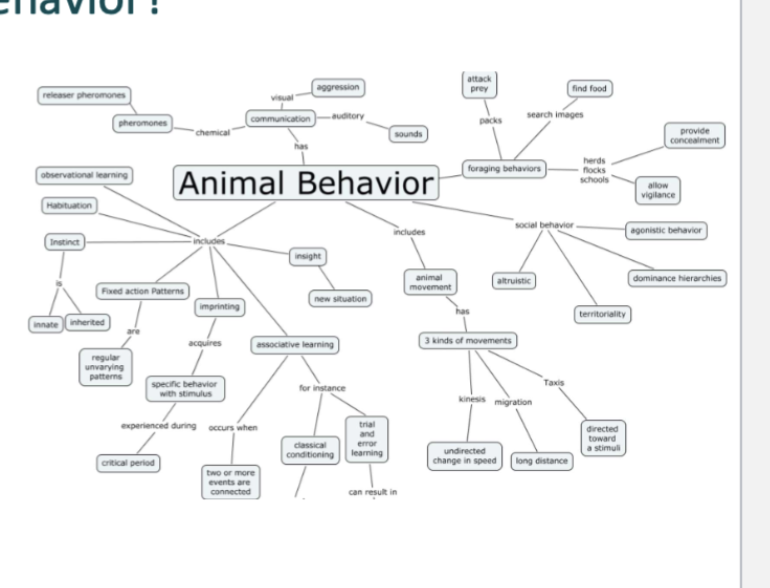
Why are we interested animal behavior
It’s fun and cool to see how animal interact
We interact with animals everyday
Impacts on animal welfare(we can learn how to take care of them)
Impacts on conservation(we can learn to take care of endangered animals)
Insights into our behaviors
Ex: A cat named Maru would climb into boxes and it was entertaining and we can learn that cats like small spaces and can fit in small spaces because of their anatomy
How did early history/humans incorporate animals into their lifes
France (40k plus years) has paintings of how they interpreted animals. Also for 1000 plus years animals interactions with humans have been recorded
Egyptians deity’s(referred to as Babi’s) had animalistic traits. They were omnivorous like monkeys and they were aggressive like monkeys but unlike monkeys they devoured souls of the sinful
Greeks-Artistole thought of animals to have good memory and be able to follow instructions but unlike us they couldn’t remember the past. He also studied how animals are similar and different from us.
Ethology means what
Ethos means character
Logia means the study of
This is the study of animal characteristics/behavior(both through field observation and experiments) from biological standpoint(instinctive behaviors)
Why is studying ethology important
devising and promoting green techonologies
policy creation against defaunation, poaching, exploitation of threatend species
revising our economy to take into accounts the real costs of animal endangerment
dietary shifts towards plant based food to persevere animals who are on brink of ceasing to exist to not exist
maintaining natures ecosystem services
prioritization of well funded and managed reserves
outdoor nature education
rewinding region with native species
What were Darwin’s Discovery of animals about?(3 things)
Similar animals exhibited BOTH similar morphologies and ritualized behaviors. Tigers and Cheetahs’s both look slender and have some strip/dot pattern going on. They also feed their cubs with milk and they run towards prey and have a sneaky tactic
Animal instincts is subject to natural selection. Monkey’s have long fingers to graph on mother’s fur, because in the past those who didn’t wouldn’t be able to grasp on the fur and would fall
Extends the argument of emotions and expression to animals. In short he thought both humans and animals can display emotions and expressions. Example: a cat can show signs of sadness and loneliness.
What quote did Darwin say that connected human behavior, emotions to animals.
“man once existed in much lower and animal-like condition”. and “the general ground and structure and habits of all animals have evolved.
In short he believe humans were like animals in the past
Animals have also gained maturity in emotions and habits(like humans)
Ethology approach through the European eyes look like what
It was field observations/ “watching and wondering”
It took place in Europe during the 1900s to 1950s
Who was Tinbergen
European ethologist between 1900s to 1950s
received a Nobel prize in animal behavior in 1973s
Introduced the idea of fixed action pattern
Introduced baby gulls pecking at the color red
What made the baby gull pecking at red experiment and who established this experiment
Was created by Niko Tinbergen
The mother gull holds red berries in its beak and the baby gull pecks at it(to eat).
This is instinctive/innate behavior. The baby naturally peaked at the red. This is also fixed action pattern because the baby is always pecking at the red.
This is also NOT LEARNED
The pecking at red experiment purpose:
to prove that the pecking at red behavior was innate/instictive.
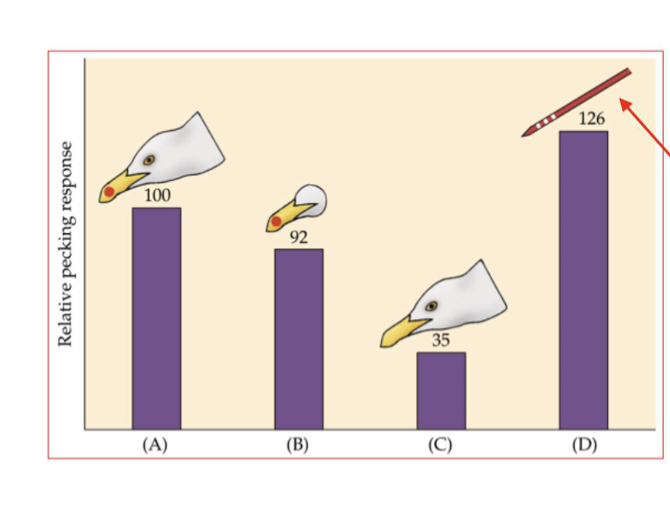
What does this image say about the baby red gull experiment and about these vocab words: fixed action pattern, innate releasing, sign stimulus, supernormal stimulus
The experiment had 4 different groups.
A was a mother with a red dot and a large head
B was a mother with a red dot but small head
C was a mother with no red dot but large head (peaked the least on this)
D was a large pencil(peaked the most on this)
Regardless of the size of the head(small or large), the baby gull just peaked at the red. This is why even the large head-C still only had 35 peaks while the smallest head with red had 92. This is why the red pencil had the biggest amount of peaks
fixed action pattern: the baby peaking at the red
innate releasing: the baby peaking at the red
sign still stimulus: the color red/the red spot
Supernormal/abnormal stimulus: The red pen. A supernormal stimulus is an exaggrated cue that results in a stronger responses than a natural stimulus in which the red pen is.
How we study animal behaviors is organized in 4 categories, what are those categories.
Remember: Animal Behavior C D E F
Proximate:
immediate factors, relevant factors, measurable during current time and development
answers the what and how
Ultimate:
focuses on survival of fittest, Darwins ideas
answers the why
Example: what lead mother Bear to nurse her babies:
positive genes(what) are released during pregnancy(how)
feeding the baby allows the baby to pass on the mother’s genes(why)
What are Tinbergen’s 4 questions
Remember: Animal Behavior C D E F
Proximate
causation(sensory-motor mechanisms)
developmental(change over lifetime)
Ultimate
Evolution(historical pathways)
Function(the purpose of x in relation to surviving)
How are Tinbergen’s 4 questions organized in Historical sequence(1963) and Slice in time(1963)
Historical Sequence:
-Evolutionary/evolution
-Developmental/ontology
Slice in time:
-Causation/mechanism
-Function/survival value
What questions does the Evolutionary/evolution concept ask
Related to Ultimate explanations
How did trait evolve?
Why did the trait evolve?
What questions does the Developmental/Ontology concept ask
Related to Proximate
How does the trait emerge across the lifespan?
What questions does the Mechanism/causation concept ask
-Related to Proximate
-How does the trait work?
-How is the trait elicited or produced?
What questions does the Function/survival value concept ask
-It relates to Ultimate
Why is the trait adaptive?
Why does the trait persist?
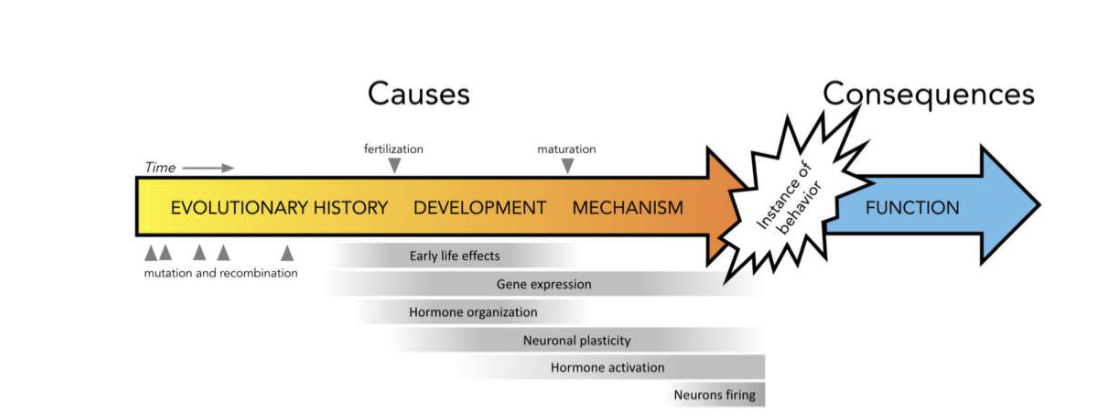
What does this image tell us
That Tinbergsten questions are holistic and interconnected.
To understand a behavior all 4 questions of Tinbergsten’s are required to understand it, NOT just 1, 2,3 BUT 4
They also are all connected. The function of a monkey’s opposable finger is reliant on understanding the evolutionary history of grasping toe
Answer the question: Why do we eat? Using the causation, development, evolution, function
Causation: we eat because hormones/stimuli signals that we are hungry
Developmental: What you eat changes over time and the amount you eat changes too
Evolution: We have similar manners of eating to other animals. Like other mammals by birth we are feed with milk, so it is natural that as we grow up we eat still
Function: We eat to survive and to bring back our blood sugar level up
Who was the first to discover that Honey-Bees have color vision
Charles Henry Turner
Who is Von Frish
European Ethologists
Would watch and observe honey bees
Made the honey-bee square vision
purpose: to prove honey-bees have color vision
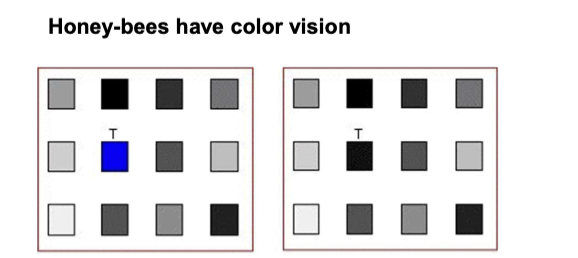
What was the honey-bees square vision test about
Purpose: Prove honey bees have color vision
Results: Honey bees with color vision went to square with color/stood out. Honey bees without color vision went to square without color/did not stand out.
Made by Von Frisch
What was the “Hive talking”/honeybees waggle dance about
Made by von frisch
The direction/angle of dance correspond to where food is
The time of duration of dance tells how far away the food is
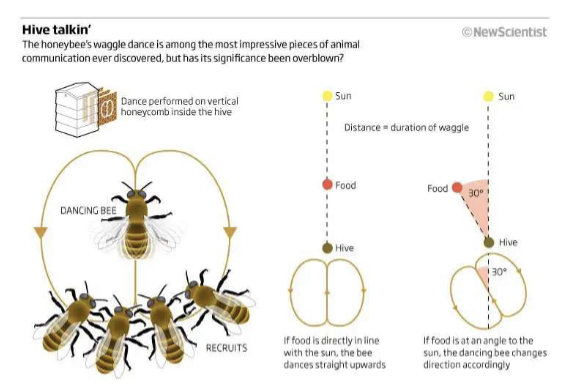
What does this image tell us
The direction of the dance is the direction of food
The time of the dance is how far away the food is
If the food is directly in line with the sun. The bee dances straight upwards
If the food is at an angle to the sun, the dancing bee changes direction accordingly
Konrad Lorenz
-Ethologist in Europe
-studied imprinting through observations
Imprinting: Lorenz was there when baby ducks hatched(there mother was not), so the ducks followed him as if he was their mother
Did Ethology occur in Europe or America
Only Europe
What is Behaviorism
Related to psychology
Focused on learned behaviors(foraging)
Took place in labs and focused on controlling experiment variables
Focused on experiments
Took place in America
During 1900s to 1950s
Who is B.F Skinner
American Behaviorist
During 1900s-1950s
He thought that “Pigeons, rat and monkeys” could be shaped into anything and they were boxes
He coined the phrase, “Give me a child, I’ll shape him into anything”
Gave no thought to evolution
Did B.F Skinner and Ivan Pavlov consider evolution or natural behavior in their studies
No, they did not consider evolution in their works
What does “Behaviorism” say about behavior
Equipotentially: any two stimuli can be associated, regardless of their nature:
This was proven through Ivan Pavlov’s experiment with dogs. Classical and operant conditioning(punishment): A dog after some time began to associate food with a bell. Whenever they heard a bell they start salivating
When it comes to behavior it is LEARNED and is not related to evolution or natural/innate behaviors
All animal behavior should be studied through a labs to prove the point that behavior is learned. Animal behavior was a lab based science
Identify who out of these “5” fit into behaviors and ethology:
-Karl Von Frish, Konrad Lorenz, Niko Tinbergen, B.F Skinner, Robert Yerkes
Ethology:
Karl Von Frish(honey-bees)
Konrad Lorenz(imprinting, part of nazi party)
Niko Tinbergen(baby gulls and red pen)
Behaviorism:
B.F Skinner(animals are boxes that can be shaped)
Robert Yerkes(Eugenics)
Who is Margaret Altman
1900s to 1984s
First women in ethology, psychobiology, and animal husbandry(cultivation/management) fields
Studied large animals in their normal habitat
Studied estrocyclics and sexual cycles in adult female mammals(especially sows)
Studied the endocrine basis fluctuation in blood calcium in veins
Participated in study of predictors of offspring quality in dairy cattle
Who was Charles Henry turner
1867s to 1923s
First person to discover that bees have color vision
First person to discover that insects can hear and alter behavior based on previous experience(insects have memory and can learn and change behavior)
Received PHD in Zoology from University of Chicago
Showed that insects were capable of learning, to show that honey bees can see in color and recognize patterns(4 years before Van Frish discovered it)
Who first discovered that insects/bees can learn, store memory, and recognize patterns
Charles Henry Turner first discovered it, then Van Frisch
What is Clever Hans and what does this tell us
Clever Hans was a horse that kick its foot on the ground to the “right number” that the experiment wanted.
The experimenter thought Clever Hans was truly smart. This was disproven
The horse would stop kicking its foot when it saw the owners facee would light up.
Clever Hans tells use that we should AVOId assuming complexity. We should assume a behavior is simple before saying it’s complex.
What are the pitfalls to avoid when studying animals
Assuming complexity
Ignoring Umwelt
ignoring natural proclivities/capabilities
stasis
Explain why WE SHOULD NOT ignore umwelt
Umwelt( a world in which an organism exists and acts as a subject): Animals have completely different sensors than we do.
So it is important that WE DO NOT avoid UMWELT(that animals perceive environment different from us)
Ex: If we ignore Umwelt we might think that birds see colors in trichromatic vision like us. However, they view in UV colors
Also, if we ignore umwelt we might think Dogs have similar sense to us but they do not.
What does a dog’s ability to detect ½ teaspoon of sugar in olympic sized pool tell us about UMWELT
They have sensitive noses
We should not ignore their umwelt
Explain how the Dogs olfactory sense works
When a dog creates in air, it goes into 2 separate paths
One red(going into olfactory), the other blue(going through lungs)
In the rear of the dog’s nose is the olfactory region(yellowish brown) with bristle like tissues that have TONS of smell receptor
When a dog breath in, it can feel which nostril an odor arrived in
When dog breathes out it it is through the side of the nose and NOT through the Nostril, it does so in a way that augments the new air coming.
Notes on how Dogs smell
dogs have a moist nose that capture ANY sense the air carries
Each nostril allows it to know the location of each sense
The air goes into 2, one for breathing and one for smelling
The smelling one has several 300 millions of them, while humans only have 5 milions
Dogs breath out through slits in the side of their nose while we breath out through nostrils
The olfactory bulb in dogs takes up lots of space
Vomeronasal organ deters hormones that all animals release. So a dog knows if its near another dog or human and it can detect emotions
Its sense also tell who has been in thehere/picks up past sense
Why should we AVOID ignoring natural proclivites/capabilites(watch video on this)
Why should we avoid stasis(watch video)
Does Behavioral evolution differ from the progress of Human evolution (true/false).
False, the progress of Human Evolution is the SAME as Behavioral evolution.
There must exist diversity in a population, then a specific trait in the population must be selected for(the trait be favorable in relation to survival), the population then evolves
In short:
Steps-
Variation Occurs
Individuals are selected
Populations evolve
What does Behavioral Evolution tell us
Almost every behavior is shaped by genes acting in a sequence or in coordinated fashion to produce a behavior
Genetic control of any particular trait is dispersed over number of neural locations.
Many neural elements= many genes
In short a behavior/trait s controlled by ANY GENES and MANY NEURAL ELEMENTS
What does the C.elegans(nematode) tell us about the interaction of genes on behavior
only has 302 neuron = 302 genes
They have 100 different genes/100 neurons involved in its locomotion/wave-like movement
18 genes/18 neurons involved in its response to touch
This tell us that multiple genes/multiple neurons are shape a behavior = most behavior is controlled by many genes
Wolf domestication(watch video)
Is nature vs nurture a true diachomty
False, to understand behavior both nurture and nature are necessary to understand a behavior
Define epigenetic
The interaction of genes and environment in terms of how they affect behavior
the interaction of nature AND nurture
It results IN HERTIABLE CHANGES but IT DOES NOT INVOLVE HERTIABLE Changes in genotype/DNA Sequence
Changes phenotype without changing GENOTYPE
How does epigenetic work(2 ways))
Epigenetics changes phenotype and gene expression by changing(BUT NOT DNA SEQUENCE and NOT GENOTYPE)
DNA Methylation- a methyl group is added to protein and it turns certain genes off
Histone Modification- changes the way DNA is packaged, impacts gene expression
In relation to Genes what does Epigenetics say
Gene expression is influenced by experience and environment(nature and Nurture)
Which does Epigenetics change: Dna sequence or Genotype
Neither